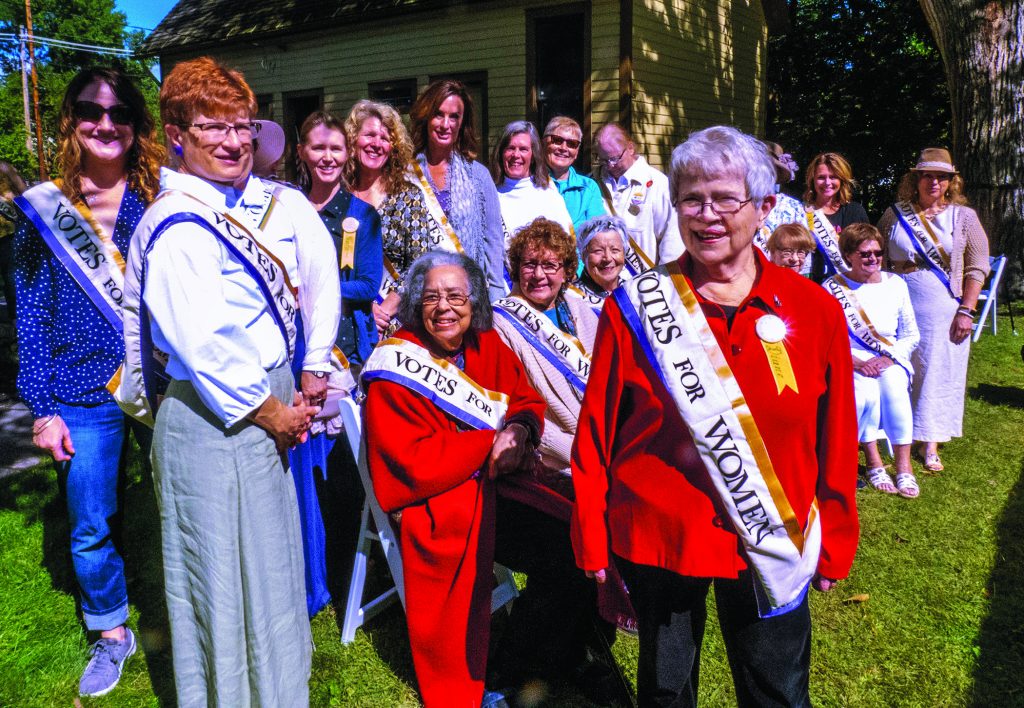
Nancy Edmonds Hanson
hansonnanc@gmail.com
“We’re here to say thanks to all the sisters who went ahead of us,” Diane Wray Williams told the crowd gathered on the lawn of the Comstock House Sunday.
Women have come a long way since 1919, when Congress sent the 19th Amendment out to the states for ratification on June 4, 1919. Minnesota became the 15th to vote in favor of passage on Sept. 8, 1919, with North Dakota coming in 19th in December. Tennessee became the last of the 36 states needed to add the measure to the U.S. Constitution on Aug. 20, 1920.
Women and men sheltered from sun in tents pitched on the lawn, celebrating the occasion with pie and coffee, cocoa and champagne. While the Hartford Street Brass played music of the day, guests “met” some of the heroines of the local fight for women’s right to vote – depicted as full-size cut-outs standing guard around the yard.
In her keynote talk, Diane cited the youth of many of the suffragists, whose long quest for the vote stretched back generations even 100 years ago. “They were so young,” she remarked, holding up a poster of leading suffragists, as they were called, of 100 years ago. “They look so earnest, so serious, so intent on their purpose. It was a tough fight, and they prevailed. We women, who make up 51% of America’s population, owe them a great deal.”
She added, “It’s great we got the vote 100 years ago, but women still need to work together, and men as well. Are we truly equal today? Much has changed, but we’re not there yet.”
The Sunday social and other events marking the words that changed the world – “The right of citizens of the United States to vote shall not be denied or abridged by the United States or by any state on account of sex” – are a joint project of the Historical and Cultural Society of Clay County, the League of Women Voters and Bonanzaville USA. A final gathering is planned Dec. 1 at Bonanzaville to commemorate North Dakota’s ratification.
HCSCC programming director Markus Krueger sifted through records of the day to identify 26 Clay County women active in the suffrage movement. Many of them, he writes in the society’s newsletter The Hourglass, were educated and educators; nine of the 25 families they represented included a teacher, and 11 had sent their children to Moorhead Normal School by 1920. Most lived in the area around the normal school and Concordia College. They represented the community’s upper crust, with husbands who were attorneys, businessmen, physicians and other local leaders. The women’s average age was 44.5 years … probably a bit younger than the average of Sunday’s contemporary crowd, who leaned toward middle age and older. Several were only a few years younger than the amendment being celebrated.
Diane, a former city council member and state representative, said the presence of so many older women Sunday came as no surprise. “I wasn’t surprised at the ages,” she confessed. “We’re the ones who’ve had the experience of knowing and recognizing our inequality. Many younger women, like my granddaughters, honestly have no idea yet. Once you get out into the working world, that’s when it hits you. Most of us never see it coming. They’ll be so disappointed.”
A century ago, the women and men who advocated for women getting the vote were already well familiar with the fight. The amendment’s language had been penned by Susan B. Anthony in 1875; 40 years later, it was still a matter of heated debate. The campaign was complicated by the temperance movement, in which many suffragists were deeply involved. Indeed, it divided residents of Moorhead, splitting the prominent anti-alcohol crusaders from those who were part of the booming tavern trade. Women’s involvement in support of the troops in World War I helped spur support of passage. Throughout the war, writes Krueger, “Suffragists picketed the White House, pointing out the hypocrisy of President Wilson ‘fighting for democracy’ abroad while ignoring democracy at home.”
In her talk, Diane cited measures of equality yet to be gained. Among the benchmarks, she said, is women’s representation in Congress. “Females account for 23% of members, though more than half of our population,” she said. The U.S. ranks 78th in the world in women’s representation in government; 50 countries have 30% or more. Six nations have legislated equal rights in the workplace for women and men, including Belgium, Denmark, France, Luxembourg, Latvia and Sweden – while here in the U.S., the Equal Rights Amendment stalled at 35 of the 38 needed states in the 1970s.
Diane urged the women and men at the centennial gathering to step up to make the promise of the 19th Amendment a stronger reality in the present day by respecting their hard-won right to vote.
“Don’t ever take it for granted. Vote – every single time in every single election,” she emphasized. “Second, talk about it. We all want to live in a community where everyone cares, women and men.
“Third, help if you can, even if it’s as simple as making sure your neighbors have rides to the polls. Finally, step up wherever you can – in school, in church, in running for office. Volunteer. To make our shared dreams for America a reality, we need to talk together and work together as a civil community. The challenge we face now is to cultivate the ability to talk with others without jumping down their throats … to logically and scientifically find ways to solve our common problems together.
“Right now our differences seem huge and angry and loud. We seem stuck. Yet the majority of people, I think, agree on what we want our country to be. We need to pull together to make the machinery work again.”


